|
Albatros D.II, D.II Oeffag and
D.III
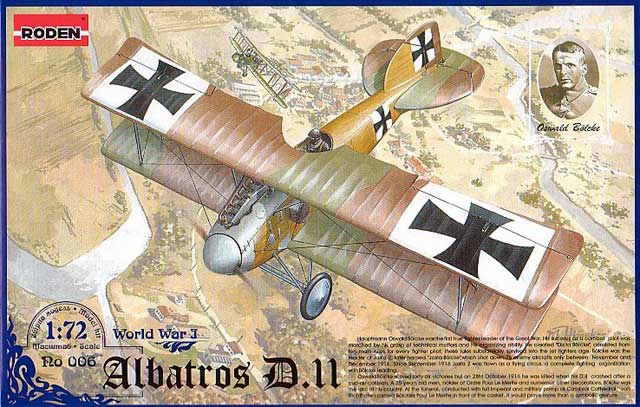
Roden

Roden's 1/72 scale Albatros D.II and III Kits are available online from Squadron.com
S
u m m a r y
|
| Catalogue Number
and Scale: |
Roden 1/72 Albatros D.II Kit No. 006
Roden 1/72 Albatros D.II Oeffag Kit No. 018
Roden 1/72 Albatros D.III Kit No. 012 |
| Contents and Media: |
Over 65 grey plastic parts;
markings for many options in each kit |
| Price: |
USD$6.96 each from
Squadron.com
|
| Review Type: |
FirstLook |
| Advantages: |
Delicate parts, well researched,
plentiful decal options |
| Disadvantages: |
Difficult fuselage assembly. |
| Recommendation: |
Recommended |
Reviewed by Robert Baumgartner
Contents
Roden continue with their Albatros fighter series with
three more welcome additions to the family. As indicated by the previous
release of the D.I, common sprues are the order of the day. While this
leads to a cheaper product because of the reduced tooling costs, it does
make assembly a bit trickier. Each kit contains over 65 well-moulded parts
with the sprues distributed as follows:
-
Albatros D.II, sprues D. B. A.
C. Z.
-
Albatros D.II Oeffag, sprues F.
B. A. C. W.
-
Albatros D.III, sprues D. E. A.
C. Z.
Lets take each kit in turn:
As expected the sprues are unchanged from the Albatros D.I kit. Sprue Z
contains our engine selection as well as the machine guns. These are
beautifully moulded and of course are used for both this and the D.III
kit. Sprue B supplies both the upper and lower wings. The trailing edges
on these parts are very thin and the surface exhibits subtle rib detail.
The top wing is in three pieces and although this looks troublesome, the
fit is almost flawless. The separate center section gives you a choice of
doing either the early version with the Windhoff radiators or late version
with the wing-mounted Teeves and Braun radiator. If choosing the former,
small sink marks will have to be filled.
Click thumbnails below to
view larger images:
The fuselage halves match the plans perfectly, which surprised me because
an early example of this sprue in the D.I kit showed this part to be
slightly short in depth. I checked the original sprue many times to make
absolutely sure that this was the case. Inside the halves there is a
delicate representation of the interior structure. There are many details
moulded onto these parts to accommodate the different variants and those
that do not apply are to be removed by the builder. This is clearly
indicated in the instruction sheet.
Sprue C. contains the many struts and these are superbly thin and as near
to scale as possible. Naturally great care must be used when removing
these.
Roden always keep the spares box full due to the commonality of sprues
between kits. Thus we have extra propellers, exhaust, engine, machine
guns, struts and wheels. The interior of all three kits comprises a seat,
control column, rudder bar, and handgrip. There is a lot more that can be
added by the modeller here, and consulting your favourite reference
material is advised.
Marking Options
An astounding nine examples are offered.
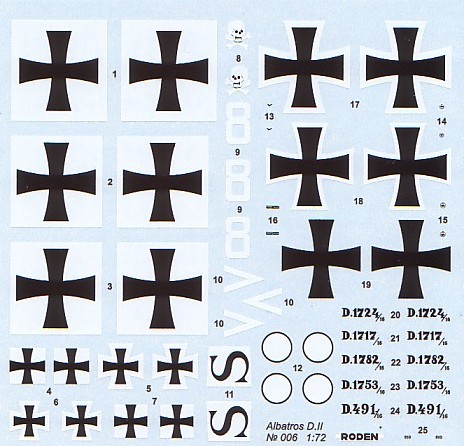
Alb. DII, 491/16 Jasta 2, Autumn 1916 flown by Ltn.
Manfred Frhr. Von Richthofen.
There is a lot of controversy regarding this machine. Some sources state
that this should be 481/16. Also note that three different photos show
that the spinner is not the same colour as the engine panels, the former
looking more like natural metal (a replacement?). As with the other
options, there is also debate as to the validity of the three colour top
surfaces on the D.II. Some may choose conventional wisdom and select a
dark green/chestnut combination.
-
Alb.DII, 1717/16 Jasta 14, 1917
flown by Oblt. Rudolph Berthold.
-
Alb.DII, 1782/16 1916 unknown
pilot and unit. Skull on fuselage band.
-
Alb.D.II, 1753/16 flown by
Godwin Brumowski training with Jasta 24. This pilot also flew Alb.D.II
1769/16 while with Jasta 24.
-
Alb.D.II, Fl.Abt.21 flown by Ltn.
Knappe. Vzfw. Richard Scholz also used this machine occasionally. Note
that apart from a circular mirror that was added to the top wing, there
was also a downward pointing flare tube below the cockpit on the starboard
side.
-
Alb.D.II, 910/16 Jasta 5 flown
by Lt. Max Boehme 1917. A much-photographed machine, it is clear that the
upper surface colours progress to the fuselage and end with the sky blue
undersides. Many will question the tri-colour scheme here, and the red
band in front of the tail assembly appears incorrect, the red/green tails
emerging after Jasta 5 switched to the D.III. Roden have missed the
repeating of the “8” in black on the underside of the fuselage.
-
Alb.D.II, 1724/16 Kampfstaffel
11, Kamfgeschwader 2, late 1916 flown by Ltn. Karl Emil Schaefer. The
wheel covers are believed to be white here. The instructions also miss the
painted out white cross-fields on the top of the wing. These being quite
discernable in the photo in darker prints of this aircraft. On the port
side of the fuselage, there should be a flare rack and a downward pointing
flare tube.
-
Alb.D.II, Oblt. Stephen Kirmaier
Jasta 2 1916
-
Alb.D.II, Hptm. Oswald Boelcke
Jasta 2.
Kit 018 Albatros
D.II Oeffag s.53
|
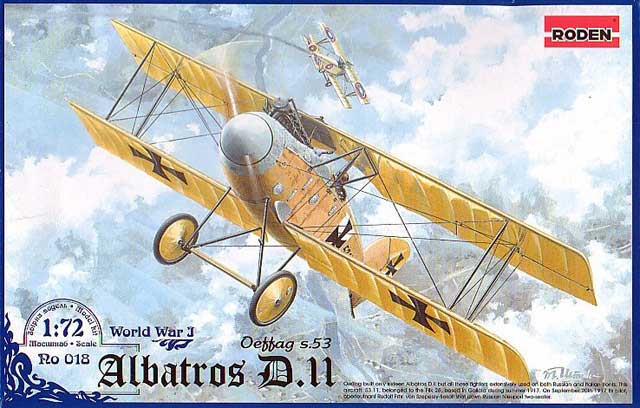
Two new sprues grace this kit to allow the building of
this license built version. Naturally a new sprue is required for the
Austro-Daimler engine. Three engine halves are provided, the extra piece
being for the upcoming Albatross D.III Oeffag kits that need the different
intake manifold on the 153 and 253 series of aircraft.
Click thumbnails below to
view larger images:
|
|

|
|
Sprue F
|
|

|
|
Sprue W
|
|
|
Apart from the aforementioned sprue W, we have sprue F.
This contains the correct larger exhaust, new propeller and revised
fuselage forward section. Thoughtfully, Roden even supply the engine hood,
which was seen on some examples. Again, we find very little discrepancy
when comparing the kits parts with published drawings.
Marking
Options
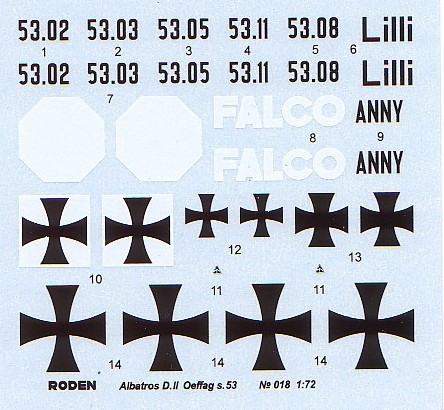
-
Alb.D.II (Oeffag), 53.03 Flik 14
flown by Fw. Rudolf Lonstak 1917.
-
Alb.D.II (Oeffag), 53.11 Flik 3D
flown by Oblt. Rudolf von Szepessy-Sokol 1917. On the 20 September 1917,
the pilot shot down a Russian Nieuport two-seater in this aircraft.
-
Alb.D.II (Oeffag), 53.08 Flik
22D 1917.
-
Alb.D.II (Oeffag), 53.02 Flik 24
flown by Fw. Julius Kowalczik 1917. Kowalczik used this plane to shoot
down a Caudron while it was on a reconnaissance mission. This was also the
first victory for this aircraft type
-
Alb.D.II (Oeffag), 53.05 Flik 25
flown by Kpl. Rudolf Blass 1917. Note that this aircraft carried an
anemometer on the right front wing strut.
-
Alb. D.II (Oeffag), A-62 (ex
53.05) flown by Zdenek Lhota 1922. The Falco Company of which Lhota was a
joint owner flew this aircraft at air shows.
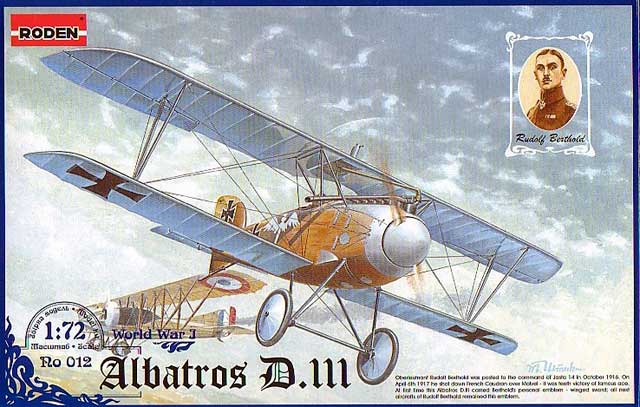
The only difference between this, and the Albatross D. II
kit is a new pair of wings. This is found on sprue E. Once again we are
blessed with very thin trailing edges and beautifully restrained rib
detail. Despite the finesse of the wings Roden have managed to provide the
modeller with a superb rendition of washout that was so obvious on this
range of fighters.
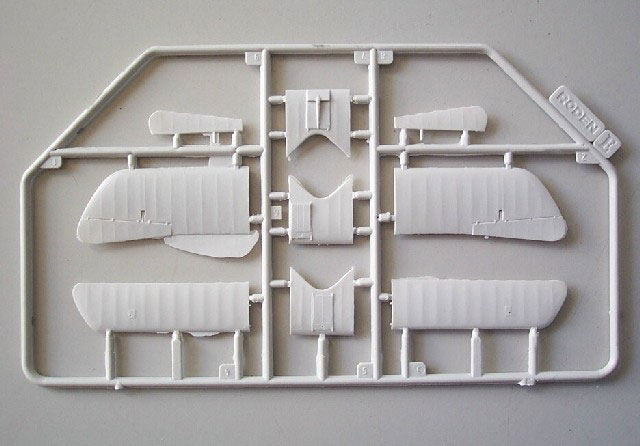
Eagle eyed viewers will recognize an additional set of
separate scalloped ailerons to be used on the upcoming series 253 Albatros
D. III. And yes, they also contain washout. The upper wing is once again
in three parts to allow for the selection of the different positioning of
radiators that were applicable to early and late versions of this fighter.
While comparison with plans show an almost perfect match,
the fastidious may want to round off the lower wing outboard leading edge
slightly. The previously mentioned sprue C gives the distinctive rudder
seen on OAW built machines.
Marking Options
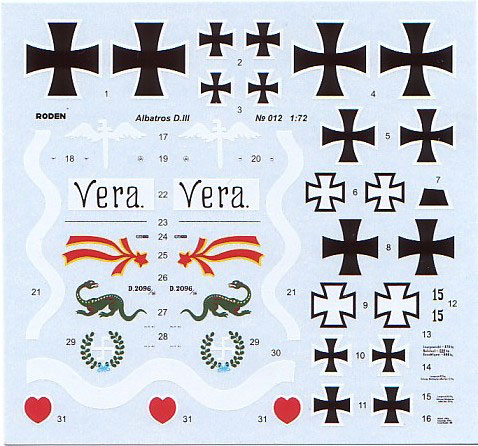
Another huge number of options offered:
-
Alb.D.III, Jasta 14 flown by
Oblt. Rudolf Berthold, 1917.
-
Alb.D.III, Jasta 11 flown by Lt.
Karl Allmenroeder, 1917. The upper wing colours are more likely tri-colour
scheme of “light Brunswick green, Venetian red and dark olive green”, than
the dark green/purple combination quoted in the instructions.
-
Alb.D.III Jasta 11 flown by Lt.
Karl Schaefer, 1917.
-
Alb.D.III Jasta 11 flown by Lt.
Lothar von Richthofen, 1917. Other sources suggest the tri-colour upper
wing pattern with a darker than usual stained fuselage. This aircraft was
a “hand me down” from his brother Manfred.
-
Alb.D.III Jasta 11 flown by Lt.
Manfred von Richthofen, 1917. Note that the Albatros logo on the tail was
not applied over the red, rather the red painted around the masked off
logo. Thus there should be a square of varnished wood on which it sits.
This aircraft would later also have its wings painted red.
-
Alb.D.III (OAW) Armee Abteilung
B 1917.
-
Alb.D.III 2096/16 captured by
the French 1917.
-
Alb.D.III Jasta 26 flown by Lt.
Bruno Loerzer 1917.
-
Alb.D.III, Jasta 10 flown by
Oblt. Erich Loewenhardt 1917.
-
Alb.D.III, Jasta 2 flown by Lt.
Werner Voss 1917. More likely this had the tri-colour upper wing surface
scheme.
-
Alb.D.III, Jasta 30 flown by Lt.
Joachim von Bertrab 1917.
These latest releases from Roden add to what is
becoming the most complete family of Albatros fighters produced. As usual,
the research that has gone into these kits is first class.
It’s a pity
that the different fuselage parts couldn’t have been made in one piece per
half per
their Fokker D.VII releases. The result is that the fit of the nose and
engine panels is not easy. Once this is overcome, however, the rest of the
assembly is plain sailing and the final result is one to please any
modeller.
Recommended.
Thanks to
Squadron.com for the review
sample.
Review and Images Copyright © 2002 by
Robert Baumgartner
Page Created 21 May, 2002
Last updated 22 July, 2003
Back to HyperScale Main Page
Back to Reviews Page
|
Home | What's
New | Features
| Gallery |
Reviews | Reference
| Forum
| Search